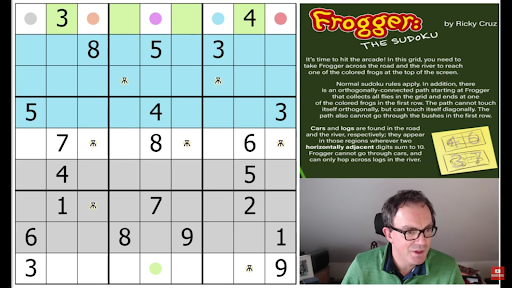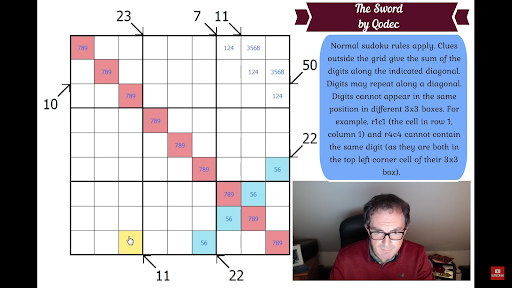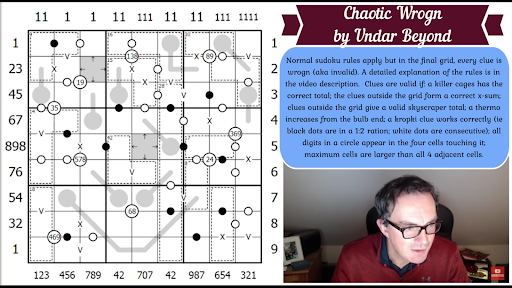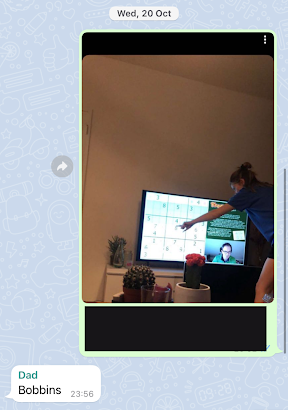
How Sudokus Brought my Dad and Me Closer Together
Sudoku probably sounds like the lamest game one could think of for most people. Some might not even consider it a game. But I don’t agree. I would go as far as calling it exciting or funny even. It is likely that I just don’t belong to “most people”. I am also convinced that at least some people just have never come across Cracking the Cryptic. Lucky for me, I have at least one person on my side, and not just any, but my dad. The Sudokus have taken up a significant place in our conversations and together we bond over the challenges, the inside jokes, and our love for numbers. In this paper, I will explore what makes Cracking the Cryptic Sudokus so exciting and how they contribute to the unique connection between my dad and me.
Cracking the Cryptic
So first of all, let me explain what Cracking the Cryptic is: a YouTube channel hosted by two world-class puzzle-solvers, on which a video is posted showing how to solve a puzzle - mostly Sudokus - every day. Oftentimes the Sudokus are submitted by Sudoku-makers, who vary from famous musicians, to masters in the puzzle community, to little boys. The Sudokus are tested by a test panel and - when selected - solved by either Mark Goodliffe or Simon Anthony. A link is always put in the description so that viewers can try to solve the Sudoku themselves using Cracking the Cryptic’s software.
There is a new element of storytelling that gives the Sudoku a new dimension
What makes Cracking the Cryptic puzzles so different from normal Sudokus are the many rules that do not belong in regular Sudokus. Figure 1 shows a Sudoku that was based on the arcade game Frogger, which is about a frog that needs to navigate a dangerous road and river to reach a female frog. The full ruleset can be seen in the Figure, but it includes avoiding cars, jumping logs, and eating insects. Not only does it add new mechanics to the game (the puzzler is able to add color to solve the Sudoku, instead of just numbers), but there is also a new element of storytelling that gives the Sudoku a new dimension (Sicart, 2008).

Figure 1: a Sudoku based on Frogger (https://www.youtube.com/watch?v=QR1-5Nfjs34 )
Apart from the storytelling with the rules and decoration of the Sudoku, sometimes the solution adds a narrative as well. The Sudoku in Figure 2, which is called “the Sword”, contained no given digits or colors, however, while making pencil-markings to solve the puzzle, a sword appeared in the grid. This not only affirms the cleverness of the puzzle-maker but also adds an element of surprise to the Sudoku.

Figure 2: a sword appears mid-solution (https://www.youtube.com/watch?v=6AfJNnzLt7M&t=948s )
And believe it or not, with these elements Sudokus can even be humorous. Figure 3 shows “Chaotic Wrogn”, which contains dozens of clues. The plot twist here is that every clue has to be false. For example, where two adjacent cells connected with an X should normally add up to 10, now they should NOT connect to 10. So when one of the cells is a 9, the other cell can not be a 1. Puzzle master Undar Beyond clearly tried to plague the puzzler as much as possible, as they also added a lot of red herrings.

Figure 3: Chaotic Wrogn (https://www.youtube.com/watch?v=zfIomUELg6c&list=WL&index=53&t=51s)
Number-nerds
While my dad and I generally are really good together, we do not necessarily have that much in common. Still, I can confidently say that we are both big number-nerds. Perhaps that could already be concluded from the fact that I described Sudokus as funny, but it also connects to the fact that he and I both really enjoy mathematics. He studied it in university and passed his knack for numbers on to me. So when my dad came across the YouTube channel and introduced it to me, it was the first of many hours spent around Cracking the Cryptic.
We do not necessarily solve Cracking the Cryptic Sudokus all that often because most of them are too difficult for us. To give an indication of just how difficult the puzzles are: a Sudoku of a 20-minute video can easily take us 1.5 hours. I think our personal record together is 45 minutes. Now imagine how long a Sudoku from a 75-minute long video would take us. We do watch a lot of videos, to see how the men from the channel solve the impossible Sudokus. The references to contemporary topics such as TV shows make the videos attractive to click on, and you can follow the thought process of the puzzlers, which makes it feel like you kind of solved the puzzle yourself. My dad and I do not watch the videos together, as I mostly watch them before sleep, and he watches them sporadically during the day. However, we do often discuss the videos when we see each other, for example over dinner. The storylines make them interesting to talk about, and one of the puzzlers who is very passionate every time he solves a puzzle has granted us many laughs and inside jokes (A good selection of phrases can be found here).
We could easily take over an hour puzzling, but it never quite felt that long
Whenever we do solve a Sudoku together, we really take the time to sit down together. As we started puzzling together in the pandemic, there was plenty of time for that. As I mentioned, we could easily take over an hour puzzling, but it never quite felt that long. What is nice about Sudokus is that they are of the game type agôn, meaning that whether you reach the goal of a finished puzzle depends on your skill, not on chance (Robinson, 2007). That in combination with the video of the solution of the Sudoku that we can refer to whenever we are stuck in the puzzle means that the odds of finishing a Sudoku - albeit with a little bit of cheating - are rather big.
Solving a Sudoku is calming to me - much unlike a shooter game - but still somewhat exciting with every new discovery that leads towards the solution. Whenever one of us finds a new clue they explain it to the other and get congratulated for their attentiveness. Sudokus are much like other games in the sense that they have an end goal and we have the motivation to finish it, dealing with conflicts on the way (Juul, 2010). Using several mechanics in the game (applying colors and different kinds of pencil markings) we are even able to create a strategy (Sicart, 2008).
Special connection
As I mentioned earlier, my dad and I do not necessarily have that much in common. And although we love each other and never argue, we just never did a lot together. But in the last year before I moved out we created many memories that I am fond of. Although the moments seemed small at the time, they add up to a unique connection that I cherish a lot. We share inside jokes, jargon, and we always have something to talk about. Whenever we puzzle together we are equal and bring unique things to the table. I will speak for myself and say that I need him to solve Sudokus, but I am not confident that the opposite is true for him. However, I will say that I at least speed up his process a little bit.
It is like we are in this exclusive community of people who know about the world of Sudokus beyond those in the newspapers
Oftentimes people are confused by our conversations and our bond that is seemingly founded on Sudokus, but we have also received words of admiration from outsiders, who appreciated the family talks, even though they did not quite understand. It is like we are in this exclusive community of people who know about the world of Sudokus beyond those in the newspapers. And although I would love it if more people shared our silly enthusiasm about these Japanese puzzles, I find it quite special to realize that nobody can replace the little moments that I share with my dad because of Cracking the Cryptic. And I find comfort in the fact that no matter where we are, the digits from 1 to 9 will always add up to 45, and he will always understand the significance of that.

Figure 4: sharing Cracking the Cryptic joy, even when we no longer live together
References
Juul, J. (2010). The game, the player, the world: Looking for a heart of gameness. Plurais Revista Multidisciplinar, 1(2).
Rogers, M. (1982). Caillois' classification of games. Leisure Studies, 1(2), 225-231.
Sicart, M. (2008). Defining game mechanics. Game Studies, 8(2), 1-14.